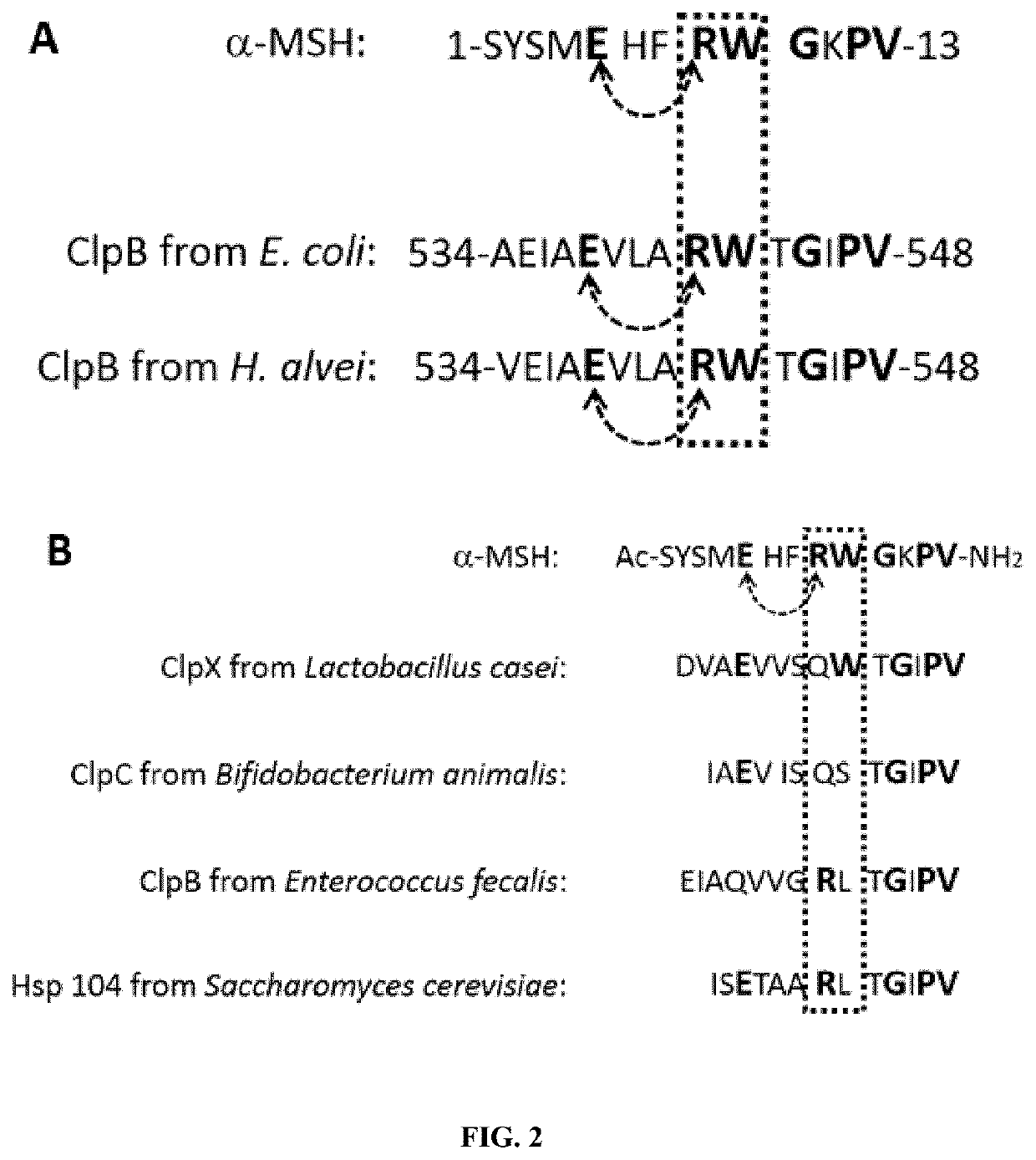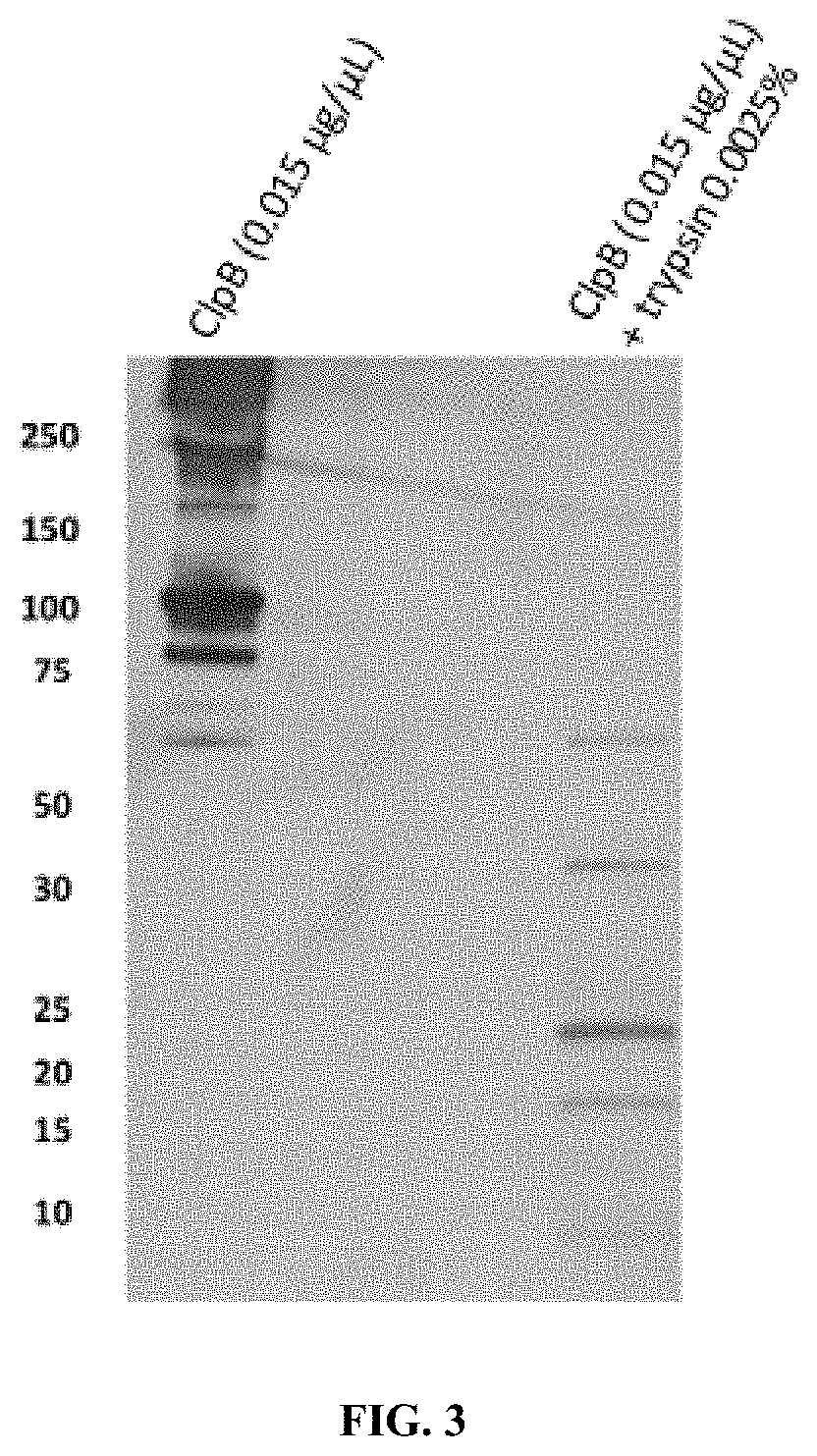Proteins derived from clpb and uses thereof
a technology of clpb and clpb, which is applied in the field of clpb-derived proteins and its use, can solve the problems of increasing blood pressure, brain risk of unwanted side effects, and increasing blood pressur
- Summary
- Abstract
- Description
- Claims
- Application Information
AI Technical Summary
Benefits of technology
Problems solved by technology
Method used
Image
Examples
example 1
ation of Bacterial Protein with Homology with α-MSH
[0270]Previous in silico analysis showed that several proteins of E. coli and some other microorganisms contain amino acid sequence homology with α-MSH, suggesting that they may be responsible for the production of α-MSH-reactive autoantibodies (Fetissov, in: Neuropsychiatric Disorders and Infection, Fatemi, S. H. (ed.), Taylor & Francis Books Ldt, 2004, pp 253-262; Fetissov et al., 2008. Nutrition. 24:348-359).
[0271]To find out which bacterial proteins may not be only theoretical but also functional α-MSH antigen-mimetics, a novel proteomic approach has been undertaken using E. coli strain K12. The novelty of this approach consisted in exploiting the well-known phenomenon of a so-called non-specific staining by primary antibodies in immunodetection protocols such as Western blot. In this approach, the “non-specific staining” of other proteins than the antigenic peptide used for antibody production was researched as a basis of a str...
example 2
Alignment Between ClpB and α-MSH
[0284]The ClpB protein of Enterobacteria has been shown to stimulate production of α-MSH-cross-reactive antibodies. The inventors therefore hypothesized the presence of an α-MSH-like epitope in the ClpB protein of Enterobacteria.
[0285]Sequence alignment between ClpB and α-MSH revealed a discontinuous 6-amino acid sequence homology within the central part (amino acid residues 534-548 of SEQ ID NO: 1) of E. coli and H. alvei ClpB (FIG. 2A). Such sequence was not predicted by an in silico analysis of homology to α-MSH in E. coli or H. alvei protein database using a search algorithm of α-MSH consecutive sequence homology. Moreover, E. coli and H. alvei proteins containing such consecutive sequences could not be identified by a proteomic approach (Fetissov et al., 2008. Transl Psychiatry, 2014, 4:e458), highlighting the difficulty for predicting the presence of peptide-like epitopes in large proteins having functional significance using in silico approach...
example 3
ments Identification
[0292]Material & Methods
[0293]ClpB Fragmentation
[0294]First the fragmentation was performed on different conditions: ClpB diluted at 1 / 10 (from the stock at 5 mg / mL) and ClpB 1 / 10 with 0.0025% trypsin. Those different conditions were placed during 20 minutes at 37° C. After incubation, the fragmentation was immediately stopped by placing tubes on ice and western blot was performed.
[0295]Western Blot
[0296]After fragmentation, Leamli solution without J-mercaptoethanol was added into tubes to perform western on 20% acrylamide SDS gel in Tris-Glycine buffer (BioRad, Hercules, USA) and transferred to a nitrocellulose membrane (GE Healthcare, Orsay, France). Then, the membrane was blocked for at least 1 h at room temperature with 5% (w / v) non-fat dry milk in TBS (10 mmol / L Tris, pH 8; 150 mmol / L NaCl) plus 0.05% (w / v) Tween 20. After blocking, the membrane was incubated overnight at 4° C. with anti-α-MSH antibody. The membrane was incubated overnight at 4° C. with rabb...
PUM
| Property | Measurement | Unit |
|---|---|---|
| Fraction | aaaaa | aaaaa |
| Length | aaaaa | aaaaa |
| Weight | aaaaa | aaaaa |
Abstract
Description
Claims
Application Information
 Login to View More
Login to View More - R&D
- Intellectual Property
- Life Sciences
- Materials
- Tech Scout
- Unparalleled Data Quality
- Higher Quality Content
- 60% Fewer Hallucinations
Browse by: Latest US Patents, China's latest patents, Technical Efficacy Thesaurus, Application Domain, Technology Topic, Popular Technical Reports.
© 2025 PatSnap. All rights reserved.Legal|Privacy policy|Modern Slavery Act Transparency Statement|Sitemap|About US| Contact US: help@patsnap.com



